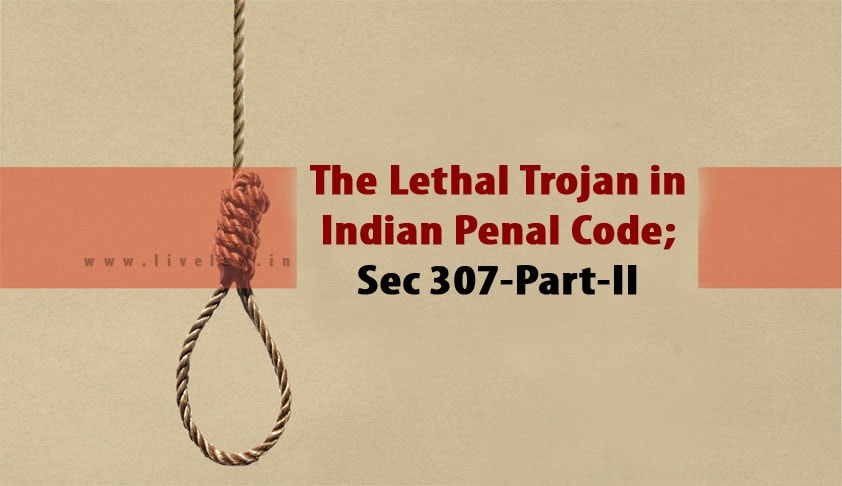The Lethal Trojan in Indian Penal Code; Sec 307-Part-II
Namit Saxena
30 Sep 2015 6:14 AM GMT
Justice Kurian Joseph opened the judgment in Sunil Damodar Gaikwad [2014] by witting - “Death and if not life, death or life, life and if not death, is the swinging progression of the criminal jurisprudence in India as far as capital punishment is concerned.” Our statute books though resistantly, provide death for social, political and economic crimes. Interestingly, two...
Justice Kurian Joseph opened the judgment in Sunil Damodar Gaikwad [2014] by witting - “Death and if not life, death or life, life and if not death, is the swinging progression of the criminal jurisprudence in India as far as capital punishment is concerned.” Our statute books though resistantly, provide death for social, political and economic crimes. Interestingly, two diametrically opposite views have been witnessed recently in this context. The 262nd Law Commission of India Report recommended abolition of death penalty save in certain cases, while on the contrary a 3 judge bench of the Supreme Court in Vikram Singh [CA No. 824/2013] approved constitutional validity of capital punishment under Sec. 364A of the Indian Penal Code (IPC).
There are 511 sections in IPC, 54 of which project Life Imprisonment as a sentence, 11 overlapping amongst these prescribe death as the maximum punishment and only 6 in this bracket are non-homicidal in nature. It is here where the Trojan lies. Sec. 307, IPC prescribes punishment for ‘Attempt to murder’. On basis of sentencing, it classifies itself into 2 parts with causing hurt as the distinguishing event i.e Life Imprisonment if hurt is caused, else 10 years. Part II of it which concerns us here, however carves out a separate class within the first class dedicated to life convicts i.e where hurt is caused, that in such an attempt, they may be punished with death.
IPC was notified in 1860 as a reaction to the 1857 uprising. Sec. 303, IPC prescribed mandatory capital punishment for life convicts who commit murder. Both, Sections 303 & 307(Part-II), were drafted with a clear legislative intent to offer protection to prison staff who were chiefly British. Sec 303 was struck down as violative of Articles 14 & 21 in Mithu Singh [1983] on 3 grounds i.e. disproportionate sentencing, creating a separate class for life convicts without intelligible differentia & rational nexus (Para 9-15) and curbing judicial discretion for sentencing. Sec. 307(II) is even weaker in the sense that death must not be caused to attract it. Even a hurt (emphasis on – not even ‘Grievous Hurt’) in the attempt is enough to draft a capital punishment. Hurt has been defined in Sec 319 IPC as ‘bodily pain, disease or infirmity’, which is punishable under Sec. 323 for a maximum of one year and under Sec. 334 (applied, if provoked) only for one month!
Sec. 307(Part-II) is unconstitutional firstly, as it violates Article 14 as held in Mithu Singh that in matter of punishment there is no rational justification to mark a distinction between a serving convict and a served/non-served one & secondly, it is highly disproportionate to punish an accused with death in a non homicidal crime only because he is serving as a life convict under any of the 54 sections or other statutes. It will be highly incorrect to say that it passes the test of Article 14 on ground claiming to be a law for repeat/second/successive offenders. A necessary concomitant of the averment here is that a life convict can be inside the prison premises or outside on bail/parole. According to National Crime Record Bureau (NCRB) there are 1394 prisons in the country with a total capacity of 3,43,169 inmates. The actual number of prisoners, much higher than the capacity, can be divided into undertrials and convicts. Overcrowded prisons occupy a variety of inmates with limited resources. Factually speaking, the unreported crime inside the premises is no less than outside. Prison violence is undeniably rampant. A life serving convict under offence of counterfeiting a coin u/s 232 has to therefore protect himself/herself from those serving identical term under murder or rape. If a fight occurs between two inmates causing a slight hurt to one, capital punishment can be attracted. As per Sec 307(Part-II), in any case, inside or outside, if one is found to have attempted murder causing any hurt, he can be executed.
It will be incorrect to say that capital punishment is constitutionally valid in India. Bachan Singh (1980) had only declared Sec. 302, IPC as not constitutionally invalid. Recently, Vikram Singh held Sec. 364A to be valid as proportionate. Mandatory death sentences and provisions which violate the constitution are undoubtedly invalid. When a second conviction for murder does not automatically qualify it as a ‘rarest of rare’ crime deserving death, how can causing hurt in an attempt be! Presence of Sec 307(Part-II) of the penal code book in form of a draconian colonial punishment rule with lethal consequences converting life convicts into death row convicts directly attacks the constitutional spirit of rule of law.
I do not advocate that this provision is used frequently, but that it must not embrace the statute book at all. It was written in Livanage v Reginam [(1966) 1 All ER 650] – “What is done once, if it be allowed, may be done again and in a lesser crisis and less serious circumstances.” Let’s hope wisdom prevails!
 Namit Saxena is a lawyer. He can be reached at namitsaxena2007@gmail.com.
Namit Saxena is a lawyer. He can be reached at namitsaxena2007@gmail.com.

